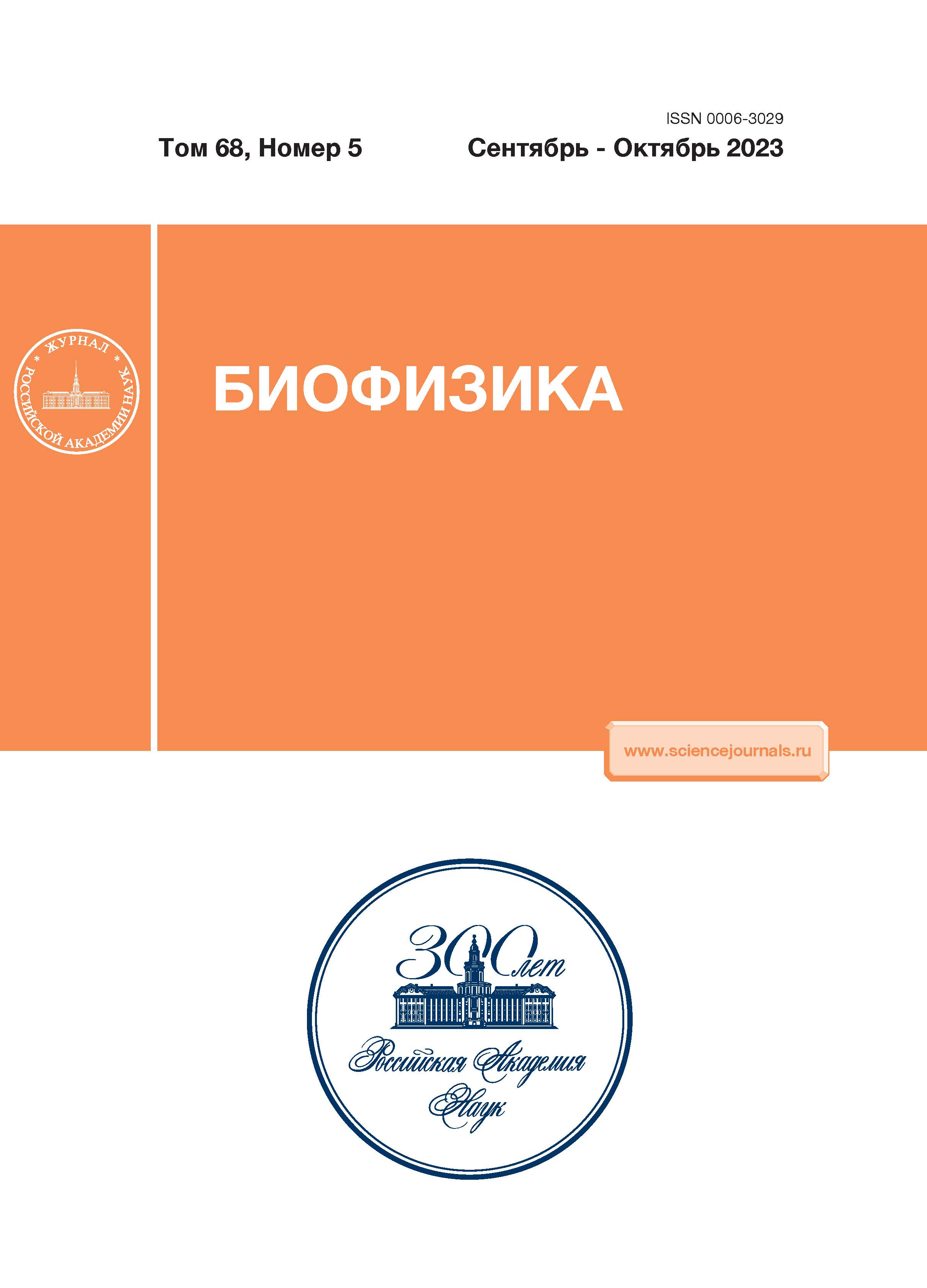The inversion of the inotropic effect of isoproterenol in the rat myocardium during deep hypothermia
- 作者: Samodurova C.V1,2, Turin F.V1, Averin A.S1
-
隶属关系:
- Institute of Cell Biophysics, Russian Academy of Sciences
- St. Petersburg State Institute of Technology
- 期: 卷 68, 编号 5 (2023)
- 页面: 1008-1013
- 栏目: Articles
- URL: https://kld-journal.fedlab.ru/0006-3029/article/view/673325
- DOI: https://doi.org/10.31857/S0006302923050216
- EDN: https://elibrary.ru/NALZOY
- ID: 673325
如何引用文章
详细
The present study examined the effects of the в-adrenergic receptor agonist, isoproterenol, on contractile activity of right ventricle papillary muscles in the rat heart at near-physiological temperature (30°C) and under conditions of deep hypothermia (10°C). Isoproterenol exerts a pronounced positive inotropic effect at 30°C. After agonist addition, the force of contraction increases from 1.2 ± 0.1 mN in control to 2.4 ± 0.4 mN that leads to a reliable acceleration of time parameters of contraction. So, time-to-maximum contraction decreased from 101 ± 6 ms to 85 ± 4 ms; time-to-50% relaxation declined from 55 ± 3 ms to 36 ± 1 ms. Under hypothermic conditions, isoproterenol produced a powerful negative inotropic effect, reducing the force of contraction from 2.2 ± 0.4 mN to 1.2 ± 0.4 mN. Similarly as at 30°C, there was a tendency for increase in contraction speed, so time-to-maximum contraction decreased from 717 ± 52 ms to 624 ± 50 ms, and time-to-50% relaxation was shortened from 667 ± 86 ms to 450 ± 40 ms. Thus, under conditions of deep hypothermia at 10°C, the isoproterenol-induced inotropy changes from positive to negative, while negative lusitropic effect remains clear.
作者简介
C. Samodurova
Institute of Cell Biophysics, Russian Academy of Sciences;St. Petersburg State Institute of TechnologyPushchino, Moscow Region, Russia;St. Petersburg, Russia
F. Turin
Institute of Cell Biophysics, Russian Academy of SciencesPushchino, Moscow Region, Russia
A. Averin
Institute of Cell Biophysics, Russian Academy of Sciences
Email: averinas82@gmail.com
Pushchino, Moscow Region, Russia
参考
- J. Arrich, N. Schutz, J. Oppenauer, et al., Cochrane Database Syst. Rev., 5, CD004128 (2023).
- T. P. Grazioso and N. Djouder, iScience, 26, 107010 (2023).
- A. F. Aslam, A. K. Aslam, B. C. Vasavada, et al., Am. J. Med., 119, 297 (2006).
- K. C. Wong, West J. Med., 138, 227 (1983).
- T. Wood and M. Thoresen, Semin. Fetal Neonatal. Med., 20, 87 (2015).
- L. Maiuskova and M. Javorka, Physiol. Res., 70, S495 (2021).
- G. Wallukat, Herz, 27, 683 (2002).
- T. D. O'Connell, B. C. Jensen, A. J. Baker, et al., Pharmacol. Rev., 66, 308 (2014).
- O. Yu. Pimenov, M. H. Galimova, E. V. Evdokimovskii, et al., Biophysics, 64 (5), 738 (2019).
- M. Khamssi and O. E. Brodde, J. Cardiovasc. Pharmacol., 16 (Suppl 5), S1337 (1990).
- A. J. Baker, Pflugers Arch.: Eur. J. Physiol., 466, 1139 (2014).
- G. Fajardo, M. Zhao, G. Berry, et al., J. Mol. Cell. Cardiol., 51, 781 (2011).
- Y. Song, C. Xu, J. Liu, et al., Circ. Res., 128, 262 (2021).
- V. Tibenska, A. Marvanova, B. Elsnicova, et al., J. Appl. Physiol. 130, 746 (2021).
- S. Moniotte, L. Kobzik, O. Feron, et al., Circulation, 103, 1649 (2001).
- T. Angelone, E. Filice, A. M. Quintieri, et al., Acta Physiol. (Oxford), 193, 229 (2008).
- R. Treinys, D. Zablockaite, V. Gendviliene, et al., J. Membr. Biol., 247, 309 (2014).
- J. Garda-Prieto, J. M. Garda-Ruiz, D. Sanz-Rosa, et al., Basic Res. Cardiol., 109, 422 (2014).
- G. Kayki-Mutlu, I. Karaomerlioglu, E. Arioglu-Inan, et al., Eur. J. Pharmacol., 858, 172468 (2019).
- C. Pott, K. Brixius, W. Bloch, et al., Pharmazie, 61, 255 (2006).
- R. Salie, A. Kh. H. Alsalhin, E. Marais, et al., Cardiovasc. Drugs Ther., 33, 163 (2019).
- E. S. Dietrichs, G. Sager, and T. Tveita, Scand. J. Trauma Resusc. Emerg. Med., 24, 143 (2016).
- A. L. Melnikov, J. E. L0keb0, D. A. Lathrop, et al., Gen. Pharmacol., 27, 665 (1996).
- L. Riishede, F. Nielsen-Kudsk, Pharmacol. Toxicol., 66, 354 (1990).
- P. Badertscher, M. Kuehne, B. Schaer, et al., BMC Cardiovasc. Disord., 17, 277 (2017).
- T. Takahiro, S. Kou, Y. Toshinobu, et al., Heart Rhythm, 12, 644 (2015).
- A. S. Averin, M. N. Nenov, V. G. Starkov, et al., Toxins (Basel), 14 (2022).
- O. Okazaki, N. Suda, K. Hongo, et al., J. Physiol., 423, 221 (1990).
- D. B. Hoover, T. R. Ozment, R. Wondergem, et al., Shock, 43, 185 (2015).
- A. S. Averin, N. M. Zakharova, D. A. Ignat'ev, et al., Biophysics, 55 (5), 910 (2010).
- N. Kondo, Circ. Res., 59, 221 (1986).
- K. J. Broadley, Br. J. Pharmacol., 45, 123 (1972).
- M. Mattheussen, K. Mubagwa, H. van Aken, et al., Anest. and Analg., 82, 975 (1996).
- S. A. Omar, D. Hammad, and S. Varma, Indian J. Physiol. Pharmacol., 23, 199 (1979).
- T. E. Tenner and J. H. McNeill, Can. J. Physiol. Pharmacol., 56, 926 (1978).
- K. J. Broadley and J. H. McNeill, Can. J. Physiol. Pharmacol, 61, 572 (1983).
- R. G. Chess-Williams and K. J. Broadley, Eur. J. Pharmacol., 108, 25 (1985).
- Y. Nakae, S. Fujita, and A. Namiki, Anest. and Analg., 93, 846 (2001).
- D. M. Bers, Circ. Res., 87, 275 (2000).
- S. Miyamoto, M. Hori, M. Izumi, et al., Jpn. J. Pharmacol., 85, 75 (2001).
- R. Carpentier and M. Vassalle, Circ. Res., 31, 507 (1972).
- J. Deleze, Circ. Res., 8, 553 (1960).
- Y. Kokoz, A. S. Grichenko, A. F. Korystova, et al., Biosci. Rep., 19, 17 (1999).
- D. Reinhardt, R. Butzheinen, O. E. Brodde, et al., Eur. J. Pharmacol., 48, 107 (1978).
- E. S. Dietrichs, T. Schanche, T. Kondratiev, et al., Cryobiology, 70, 9 (2015).
补充文件









